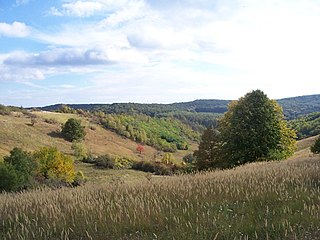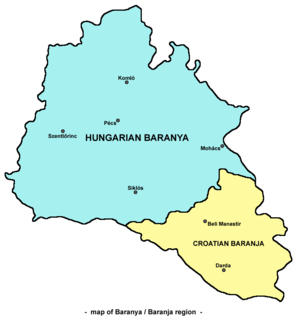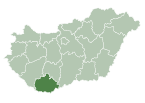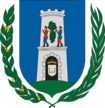
Baranya is a county in southern Hungary. It is part of the Southern Transdanubia statistical region and the historical Baranya region, which was a county (comitatus) in the Kingdom of Hungary dating back to the 11th century. Its current status as one of the 19 counties of Hungary was established in 1950 as part of wider Soviet administrative territorial reform following World War II. It is bordered by Somogy County to the northwest, Tolna County to the north, Bács-Kiskun County and the Danube to the east, and the border with Croatia to the south.

Baranya or Baranja is a geographical and historical region between the Danube and the Drava rivers. Its territory is divided between Hungary and Croatia. In Hungary, the region is included into Baranya county, while in Croatia, it is included into Osijek-Baranja county.

Baranya was an administrative county (comitatus) of the Kingdom of Hungary. Its territory is now divided between present-day Baranya County of Hungary and Osijek-Baranja County of Croatia. The capital of the county was Pécs.

Beli Manastir is a town in eastern Croatia. It is the principal town of the Croatian part of Baranja, located in the Osijek-Baranja County.

Mohács is a town in Baranya county, Hungary on the right bank of the Danube.

The Serb–Hungarian Baranya–Baja Republic was a short-lived, Soviet-oriented mini-state, proclaimed in Pécs on 14 August 1921, on occupied Hungarian territory during the peacemaking aftermath of the first World War, tolerated and fostered by the newly proclaimed Kingdom of Serbs, Croats and Slovenes. Its territory included the geographical region of Baranya and the northern part of Bačka region, as well as a portion of the Banat.

Abaliget is a village in central Baranya County, Pécs District, in southern Hungary. Until the end of World War II, the majority of the Inhabitants was Danube Swabians, also called locally as Stifolder, because there Ancestors once came at the 17th century and 18th century from Fulda (district). Mostly of the former German Settlers was expelled to Allied-occupied Germany and Allied-occupied Austria in 1945-1948, about the Potsdam Agreement. Only a few Germans of Hungary live there, the majority today are the descentant of Hungarians from the Czechoslovak–Hungarian population exchange. They got the houses of the former Danube Swabians Inhabitants. It is located in the western Mecsek Mountains. The nearby Abaliget Cave and the area's lakes and hiking trails make it a popular tourist destination. Its population at the 2011 Census was 598.

Babarc is a village and municipality in Baranya county, Hungary. Until the end of World War II, the Inhabitants was Danube Swabians, also called locally as Stifolder, because there Ancstors was from Fulda (district). Mostly of the former German Settlers was expelled to Germany and Austria in 1945-1948, about the Potsdam Agreement. Only a few Germans of Hungary live there, the majority today are the descentant of Hungarians from the Czechoslovak–Hungarian population exchange. They got the houses of the former Danube Swabians Inhabitants.

Bezedek is a village in Baranya county, Hungary. Until the end of World War II, the Inhabitants was Danube Swabians. Mostly of the former German Settlers was expelled to Germany and Austria in 1945–1948, about the Potsdam Agreement. Only a few Germans of Hungary live there, the majority today are the descentant of Hungarians from the Czechoslovak–Hungarian population exchange. They got the houses of the former Danube Swabians Inhabitants.

Kiskassa is a village in Baranya county, Hungary. It is located 17 kilometers to the south-east of the city Pécs, the capital city of Baranya. Until the end of World War II, the majority of the Inhabitants was Danube Swabians, also called locally as Stifolder, because there Ancestors once came at the 17th century and 18th century from Fulda (district). Mostly of the former German Settlers was expelled to Allied-occupied Germany and Allied-occupied Austria in 1945-1948, about the Potsdam Agreement. Only a few Germans of Hungary live there, the majority today are the descentant of Hungarians from the Czechoslovak–Hungarian population exchange. They got the houses of the former Danube Swabians Inhabitants.
Ág is a village in northern Baranya County, Hegyhát District, in southern Hungary. Its population at the 2011 Census was 177. Until the end of World War II, the majority of the Inhabitants was Protestant Danube Swabians, Mostly of the former German Settlers was expelled to Allied-occupied Germany and Allied-occupied Austria in 1945-1948, about the Potsdam Agreement. Only a few Germans of Hungary live there, the majority today are the descentant of Hungarians from the Czechoslovak–Hungarian population exchange. They got the houses of the former Danube Swabians Inhabitants.
Aranyosgadány is a village in central Baranya County, Pécs District, in southern Hungary. It is located in the western Baranya Hills. It was established in 1941 with the merger of the settlements of Keménygadány and Pécsaranyos. Its population at the 2011 Census was 355.

Kisbudmér is a village and municipality in Baranya county, Hungary.

Kishajmás is a village in Hegyhát District, northern Baranya county, in the Southern Transdanubia region of Hungary. Its population at the 2011 census was 209.
Markóc is a village in Baranya county, Hungary.
Monyoród is a village and municipality in Baranya county, Hungary. Until the end of World War II, the majority of the Inhabitants was Danube Swabians, also called locally as Stifolder, because there Ancestors once came at the 17th century and 18th century from Fulda (district). Mostly of the former German Settlers was expelled to Allied-occupied Germany and Allied-occupied Austria in 1945-1948, about the Potsdam Agreement. Only a few Germans of Hungary live there, the majority today are the descentant of Hungarians from the Czechoslovak–Hungarian population exchange. They got the houses of the former Danube Swabians Inhabitants.
Patapoklosi is a village in Baranya county, Hungary.

Pócsa is a village and municipality in Baranya county, Hungary. Residents are Magyars, with minority of Germans. Until the end of World War II, the majority of the Inhabitants was Danube Swabians, also called locally as Stifolder, because there Ancestors once came at the 17th century and 18th century from Fulda (district). Mostly of the former German Settlers was expelled to Allied-occupied Germany and Allied-occupied Austria in 1945-1948, about the Potsdam Agreement. Only a few Germans of Hungary live there, the majority today are the descentant of Hungarians from the Czechoslovak–Hungarian population exchange. They got the houses of the former Danube Swabians Inhabitants.
Tormás is a village in Hegyhát District, northern Baranya county, in the Southern Transdanubia region of Hungary. Its population at the 2011 census was 301.














